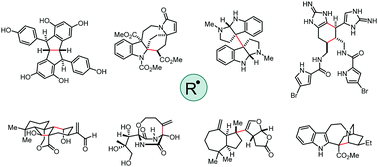Radicals in natural product synthesis
Abstract
Free radical intermediates have intrigued chemists since their discovery, and an ever-increasing appreciation for their unique reactivity has resulted in the widespread utilization of these species throughout the field of chemical synthesis. This is most evident from the recent surge in the application of intermolecular radical reactions that feature in complex molecule syntheses. This tutorial review will discuss the diverse methods utilized for radical generation and reactivity to form critical bonds in natural product total synthesis. In particular, stabilized (e.g. benzyl) and persistent (e.g. TEMPO) radicals will be the primary focus.

- This article is part of the themed collection: New Directions in Natural Product Synthesis


 Please wait while we load your content...
Please wait while we load your content...
